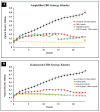Cannabis sativa CBD Extract Exhibits Synergy with Broad-Spectrum Antibiotics against Salmonella enterica subsp. Enterica serovar typhimurium
- PMID: 36557613
- PMCID: PMC9784314
- DOI: 10.3390/microorganisms10122360
Cannabis sativa CBD Extract Exhibits Synergy with Broad-Spectrum Antibiotics against Salmonella enterica subsp. Enterica serovar typhimurium
Abstract
New generation antibiotics are needed to combat the development of resistance to antimicrobials. One of the most promising new classes of antibiotics is cannabidiol (CBD). It is a non-toxic and low-resistance chemical that can be used to treat bacterial infections. The antibacterial activity of Cannabis sativa L. byproducts, specifically CBD, has been of growing interest in the field of novel therapeutics. As research continues to define and characterize the antibacterial activity that CBD possesses against a wide variety of bacterial species, it is important to examine potential interactions between CBD and common therapeutics such as broad-spectrum antibiotics. In this study it is demonstrated that CBD-antibiotic (combination of CBD and antibiotic) co-therapy can effectively fight Salmonella typhimurium (S. typhimurium) via membrane integrity disruption. This research serves to examine the potential synergy between CBD and three broad-spectrum antibiotics (ampicillin, kanamycin, and polymyxin B) for potential CBD-antibiotic co-therapy. In this study, it is revealed that S. typhimurium growth is inhibited at very low dosages of CBD-antibiotic. This interesting finding demonstrates that CBD and CBD-antibiotic co-therapies are viable novel alternatives to combating S. typhimurium.
Keywords: Salmonella; cannabidiol; cell-membrane integrity; co-therapy; novel antibacterial agents.
Conflict of interest statement
The authors declare no conflict of interest.
Figures










References
-
- Long T., Wagner M., Demske D., Leipe C., Tarasov P.E. Cannabis in Eurasia: Origin of Human Use and Bronze Age Trans-continental Connections. Veget. Hist. Archaeobot. 2017;26:245–258. doi: 10.1007/s00334-016-0579-6. - DOI
-
- Crini G., Lichtfouse E., Chanet G., Morin-Crini N. Applications of Hemp in Textiles, Paper Industry, Insulation and Building Materials, Horticulture, Animal Nutrition, Food and Beverages, Nutraceuticals, Cosmetics and Hygiene, Medicine, Agrochemistry, Energy Production and Environment: A Review. Environ. Chem. Lett. 2020;18:1451–1476. doi: 10.1007/s10311-020-01029-2. - DOI
LinkOut - more resources
Full Text Sources
Research Materials

